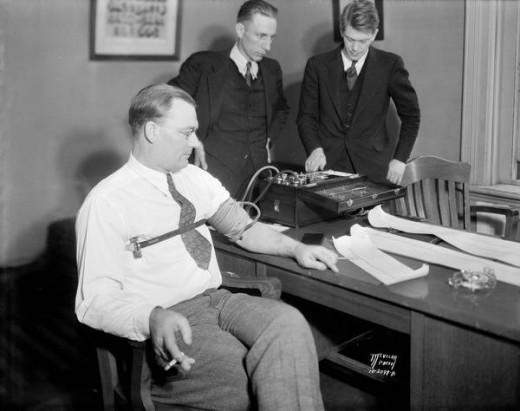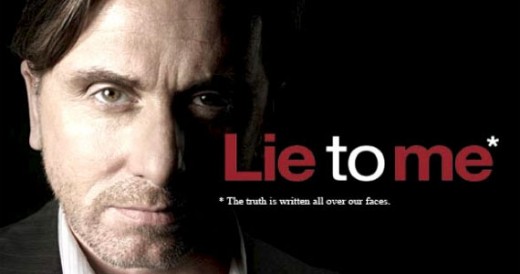Lie Detection...Pseudoscience or Just BS (Believable Stuff).

I'll let you in on a little secret of mine. I've secretly always wanted to be a polyrgraph examiner. Why? Cause TV and movies make it look so damn cool. Nice suits, slick (often metallic) briefcases, being part mind-reader/part-judge, dissecting the human conscience with surgical precision, being a hit with the ladies (ok I exaggerate...but you get my point). So imagine my disappointment when I found out that polygraph readings are only slightly better than chance guesses. And that they can be fooled with the proper coaching and prior knowledge.
Ok, well maybe polygraphs are more akin to palm reading but there are at least a dozen other forms of lie detection out there. They can't all be worthless. Written below, is my attempt to highlight each current method of lie detection in their entirety. Warning: The following methods range on a sensibility scale from archaic lunacy to crazed mad-scientist. Do not attempt any of these methods at home....You Will Lie. (Any 1,000 Ways fans out there.)
fMRI
Let's start with the brain; supposedly the center of all lies and involuntary bad thoughts. The first method, fMRI (functional magnetic resonance imaging), is used to analyze the brain to find out whether or not a lie has been told (or at least thought about). The way fMRI goes about this is to detect and depict changes in blood flow within the brain via a magnetic field. By assumption, parts of the brain that display increased blood flow will have increased activity.
Through experimentation, researchers have found that increased activity in the prefrontal and parietal lobes are associated with lying or at least suppressing a truthful statement. Therefore, by looking at these brain areas researchers hope to be able to make an efficient, infallible lie -detector. Well, did they do it? Not quite yet.
The Problems:
- Well to start, the reliability of the fMRI method is still...uh... less than perfect. Tests have revealed the fMRI to be accurate between 78% and 90% of the time depending on the situation/scenario.
- This method brings with it all the other problems involved with using an MRI machine: you can't have metal in or on your body (sorry Tin Man), you can't move around inside the machine, and it's probably best if your not claustrophobic.
Polygraph Testing
And now for my favorite (and most controversial) method, polygraphy. Polygraphy involves monitoring different aspects of the peripheral nervous system. These include blood pressure, skin conductivity, respiration, pulse and in some cases a voice stress analysis. These indices are usually tested together in various combinations.
The general format for the polygraph based- lie detection tests is to ask a series of control questions followed by a stim test in order to confirm the examiner's ability to detect a lie. This is then later followed by a series of relevant and irrelevant questions to elicit truthfulness on a specific question or set of questions. Variations of this format exist in an attempt to increase the reliability or accuracy of polygraph exams.
The Problems:
The controversy surrounding polygraphy regards its status as both a "scientific" process, a reliable process, and an admissible part of the U.S. legal system. For instance:
- Despite claims of high accuracy ranging from 80% to 95%, as stated by the American Polygraph Association; many among the scientific community view the test as inherently unscientific. The primary reason being that the questioning technique cannot be standardized or the conditions specifically repeated.
- There is a terribly long and documented history of people who have found ways to fool the polygraph or at least give the examiner obviously false readings. Most famous among them...the entire damn KGB.
- In the late 1990s, the U.S. Supreme Court officially made it up to individual jurisdictions whether or not polygraph results were admissible in court cases. Of course, no individual can be forced to take the test (but hey c'mon, every jury thinks that the guy who refuses the test is guilty.). Combined with the test's perceived unreliability, its undue influence on juries makes some opponents of the technology peeeeeved.

Microexpressions
In psych labs, research firms, and apparently TV studios across the U.S, a new dark art is being explored. Imagine the ability to discern someone's true feelings or opinions by the slightest twitch of the cheek. Well this is exactly what the study of microexpressions may bring about. According to Psychology Today, microexpressions are "fleeting facial expressions that occur when some people try to repress or suppress an emotion." Assuming the emotion being repressed is strong enough, its remnants may still appear on an individual's face for as long as 1/25 to 1/125th of a second. Who knew my face could move that fast?
Recent productions such as Lie To Me and Robert Ludlum's The Ambler Warning, depict individuals who can expertly read microexpressions to detect lies, deceit and bad acting. And yet the coolest thing about this is that there is actually a small portion of the population more attuned to microexpressions that the rest of us. I personally call them mutant facial twitch stalkers but this article would prefer to call them "wizards."
The Problem:
I knew it was too good to be true. Apparently, microexpressions are half as useful and about a third less fun than emoticons :-(. Why?
- Although they seem to show themselves involuntarily and are hard to fake, microexpressions are highly subject to influences from the surrounding environment. In other words, that sudden facial twitch might have been a lie......or it could have been a mild stroke, you just can't tell.
Other....Weirder Methods
Handwriting:
So apparently we unconsciously write truthful and untruthful sentences differently, even when we try not to. Thank God for keyboards. Read here for more info.
Software:
As if computer's weren't smart enough, soon they'll be able to detect a lie in my speech pattern. Click here to read more






